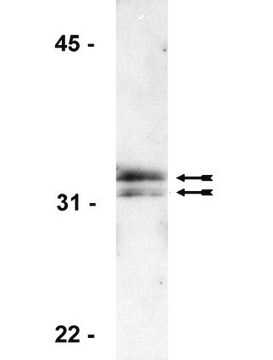MAB3864
Anti-DNA/Histone H1 Antibody
Chemicon®, from mouse
Synonim(y):
Anty-DJ221C16.5, Anty-H1.4, Anty-H1E, Anty-H1F4, Anty-H1s-4, Anty-HIST1H1E, Anty-RMNS
About This Item
Polecane produkty
pochodzenie biologiczne
mouse
Poziom jakości
forma przeciwciała
purified antibody
rodzaj przeciwciała
primary antibodies
klon
monoclonal
reaktywność gatunkowa (przewidywana na podstawie homologii)
all
producent / nazwa handlowa
Chemicon®
metody
ELISA: suitable
flow cytometry: suitable
immunocytochemistry: suitable
immunohistochemistry: suitable
izotyp
IgG2a
numer dostępu NCBI
numer dostępu UniProt
Warunki transportu
wet ice
docelowa modyfikacja potranslacyjna
unmodified
informacje o genach
human ... H1-1(3024)
Powiązane kategorie
Specyficzność
Immunogen
Zastosowanie
Immunohistochemistry: 5-10 μg/mL on paraformaldehyde or B5 fixed tissue sections.
Flow cytometry: 5-10 μg/mL using 2% paraformaldehyde fixed cells.
ELISA, direct and indirect
Optimal working dilutions must be determined by end user.
STAINING PATTERN:
Nuclear staining observed. Dense staining of nuclei. No staining of nucleoli.
Epigenetics & Nuclear Function
Histones
Postać fizyczna
Przechowywanie i stabilność
Inne uwagi
Informacje prawne
Oświadczenie o zrzeczeniu się odpowiedzialności
Nie możesz znaleźć właściwego produktu?
Wypróbuj nasz Narzędzie selektora produktów.
Kod klasy składowania
12 - Non Combustible Liquids
Klasa zagrożenia wodnego (WGK)
WGK 2
Temperatura zapłonu (°F)
Not applicable
Temperatura zapłonu (°C)
Not applicable
Certyfikaty analizy (CoA)
Poszukaj Certyfikaty analizy (CoA), wpisując numer partii/serii produktów. Numery serii i partii można znaleźć na etykiecie produktu po słowach „seria” lub „partia”.
Masz już ten produkt?
Dokumenty związane z niedawno zakupionymi produktami zostały zamieszczone w Bibliotece dokumentów.
Nasz zespół naukowców ma doświadczenie we wszystkich obszarach badań, w tym w naukach przyrodniczych, materiałoznawstwie, syntezie chemicznej, chromatografii, analityce i wielu innych dziedzinach.
Skontaktuj się z zespołem ds. pomocy technicznej






